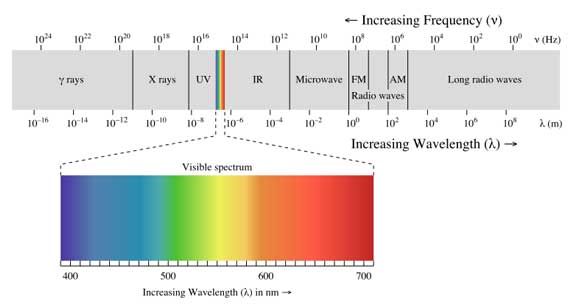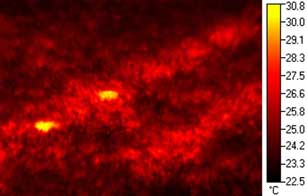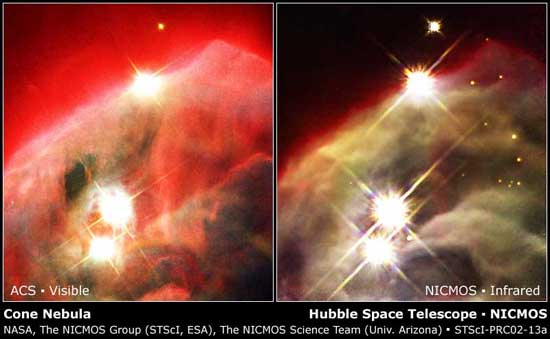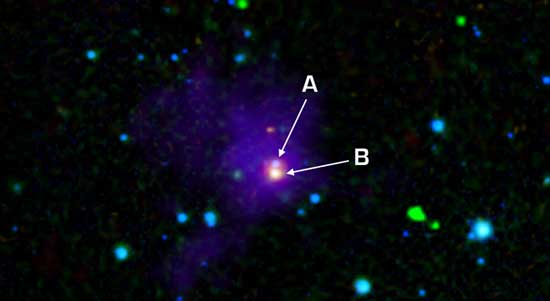Infrared Light
Seeing What You Can't See
By Kendra Rand
What do night vision goggles, land mine detectors, and studies of the universe have in common?
These may seem rather unrelated, but they have one thing in common. In some way, all of them are connected to a small range of light sandwiched between visible light and microwaves on the electromagnetic spectrum -- infrared light.
Infrared’s place in the world
Human eyes are sensitive to visible light: red, orange, yellow, green, blue, and violet light and all of the shades in between. However, visible light accounts for only a small portion of the total light in the universe.
Radio waves, x-rays, and microwaves are all types of light. The electromagnetic spectrum, shown below, is commonly used to show the different types of light.

By Philip Ronan, http://en.wikipedia.org/wiki/File:EM_spectrum.svg, under GNU Free Documentation License, Version 1.2.
Infrared light, called “IR” in the spectrum above, is just out of range of what the human eye can detect. But that doesn’t mean we can’t use infrared light to see things!
Seeing in the Dark: Night Vision Goggles


Giraffes and turtles from the Santa Barbara Zoo seen through an infrared camera. These images show that warm blooded giraffes glow with more infrared light compared to cold blooded turtles.
Courtesy NASA/JPL-Caltech, Linda Hermans-Killam

U.S. Army photo by Spc. Lee Davis.
Seen through a night-vision device, paratroopers conduct a raid on a suspected terrorist's home in Fallujah, Iraq. The Soldiers are assigned to the 82nd Airborne Division's Company B, 1st Battalion, 505th Parachute Infantry Regiment.
If you need to find someone hiding in the shadows, grab a pair of night vision goggles. The greenish images they produce enable law enforcement, military personnel, hunters, and even science hobbyists to see what is happening even in complete darkness. There are three different types of night vision devices, all which depend on infrared light in different ways.
Thermal Imaging
If you are in complete darkness, you’ll want to use thermal imaging night vision goggles. All people, places, and things give off far* infrared light in an amount proportional to their temperature. Thermal imaging goggles create an electronic image based on the temperature differences in the scene--hotter objects appear brighter than cooler objects. The contrast could be displayed in shades of pink, blue, or any other color, but green is most useful because the human eye can distinguish more shades of green than any other color.
*Far infrared light refers to infrared light near the microwave part of the spectrum.
Low Light Imaging
Low light night vision goggles require that there is some light in the area. They work by intensifying the light signals, sort of like a speaker that amplifies sound when you turn up the volume. The goggles take the ultraviolet, visible, and near infrared light in the scene and use electronics to amplify the signals and create a visible picture of the scene. Low light goggles create the most detailed image of the three types--detailed enough that it is possible to identify specific people in the scene.
Near infrared Imaging
This technique requires two parts--an infrared emitter and an infrared detector. The emitter sends out infrared light, and then the detector records the picture. You can think of the process kind of like using the flash on a camera. When you take a picture the flash lights up the object in focus, and makes the image brighter in the photograph. Only in this case, the flash is in infrared light instead of visible light. This technology is useful in cases where you want to see what is going on without shining visible light on the scene, such as in security systems.
*Near infrared light refers to infrared light near the visible part of the spectrum.
Research
Seeing Underground: Detecting Land Mines
The United Nations estimates that there are currently 100 million landmines around the world, in nearly 80 countries. Many of these countries do not have accurate records of where the mines are. Because landmines are designed to explode under the weight of unsuspecting passersby and so are not well marked, those still in existence present a great threat to civilians in the area.
Most land mine detectors consist of a variety of sensors that record the conditions of the area and look for abnormalities. Thermal imaging is often used because there are detectable differences in how explosive devices and the surrounding soil absorb and release heat. This causes a pattern of temperature changes over the surface of a mine that is different than over regular soil, which can give scouts a heads up to take a closer look at the area.

An image taken by an infrared camera which shows the thermal signatures of two simulated landmines buried in soil (shown by yellow dots).
As you might imagine, the type of soil, moisture content, and amount of sunlight can all impact infrared readings, so scientists are doing experiments to model the effect of these variables on the accuracy of the detectors. The image below is from the test of a detection method designed by engineers at Ryerson University and the American University of Beirut in Lebanon, which showed that an infrared beam could easily identify detonators buried under two centimeters of soil or less.
Other sensors that might be used in conjunction with infrared mapping include metal detectors (although most recent mines were made with non-metallic weapon), ground penetrating radar systems, and devices that look for changes in the magnetic field of the area. Scientists are continually working to make safer, more accurate mine detection systems.
Seeing through Dust and Gas: Imaging the Universe
As telescopes have evolved from crude spyglass models to sophisticated satellites that orbit the Earth, our understanding of the universe has grown in leaps and bounds. This is because we have been able to see farther into the visible universe, and because advances in technology have enabled us to see the universe in different kinds of light.
The two pictures below show the same object, a cloud of gas and dust in space called a nebula. The picture on the left shows the nebula in visible light, and the picture on the right shows the nebula in near infrared light (with color added to show the contrasts).

Nicmos (the Near Infrared Camera and Multi-Object Spectrometer) peels away layers of dust to show the inner region of a dusty nebula.
The picture taken in visible light (left) contains a lot of information about the nebula, but in the upper right corner of the infrared picture (right) you will see a number of stars that do not appear in the visible picture. This is because there is a lot of gas and dust between the stars and the camera. Visible light coming from the stars is obscured by the dust and gas, but infrared light coming from the stars passes right though it. Infrared images often show more details about the structure of objects in space because it lets us see through surrounding gas and dust.
In addition to learning more about objects we already know, looking at the sky in infrared light shows us things that are otherwise invisible. For example, brown dwarfs are objects that are sort of in the middle between regular stars and giant gas planets like Jupiter. Brown dwarfs don’t give off visible light, but they do give off infrared light that we can detect.

This image shows two young brown dwarfs, objects that fall somewhere between planets and stars in terms of their temperature and mass.
Image credit: NASA/JPL-Caltech/Calar Alto Obsv./Caltech Sub. Obsv.
For more details on these and other uses of infrared light, check out the links in the next section.
Links
NASA
The Electromagnetic Spectrum
Electrophysics
How Night Vision Works
Ryerson University
Infrared imaging makes landmine detection more safe, faster
Infrared Processing and Analysis Center & the SIRTF Science Center
Cool Cosmos: Infrared Astronomy Tutorial
Infrared Zoo
How Stuff Works
How Remote Controls Work
The Wide-field Infrared Survey Explorer will map the whole sky in infrared.
http://wise.ssl.berkeley.edu/
Check out this recent BBC story on how “glowing bugs” might become a useful detection tool.














